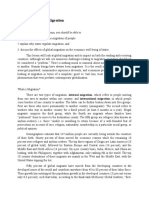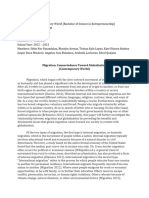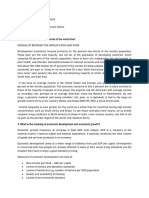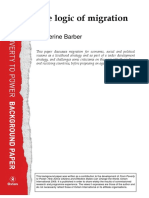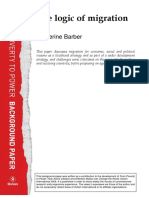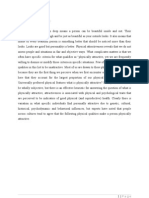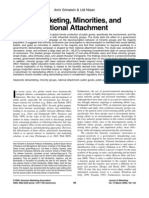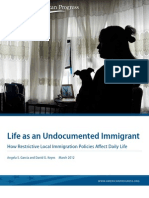204 Final Term Paper.
204 Final Term Paper.
Uploaded by
AbuBakarSiddiqueCopyright:
Available Formats
204 Final Term Paper.
204 Final Term Paper.
Uploaded by
AbuBakarSiddiqueCopyright
Available Formats
Share this document
Did you find this document useful?
Is this content inappropriate?
Copyright:
Available Formats
204 Final Term Paper.
204 Final Term Paper.
Uploaded by
AbuBakarSiddiqueCopyright:
Available Formats
1.
INTRODUCTION
Migration is a very old phenomenon. From the very beginning of human civilization people migrated for food and security. Now people migrate for economic opportunity and income security. International migration gives a person an opportunity for higher income and better lives. The higher income of the migrated person not only changes his destiny, but also has positive impact of the lives of his family in the home country. Furthermore, migration reduces the pressure of unemployment in the country. Remittance has become an important aspect for the developing countries for socioeconomic development of the country. It plays a significant role to maintain balance of payment and foreign currency reserve. Remittance also has a significant contribution in Gross Domestic Product (GDP) of the country. So To boost the Remittance flow, nowadays government takes various initiatives and utilizes it for economic developments. In 2003, the Global Development Finance Annual Report took formal notice of remittances as a source of external development finance for the first time. In the year 2000, remittance flow was over US $72 billion and among this amount the developing countries represent a large proportion of world financial flows and the amount was substantially more than global official development assistance, more than capital market flows and more than half of foreign direct investment flows to these countries.1 Remittances have emerged as a key driver of economic growth and poverty reduction in Bangladesh, increasing at an average annual rate of 19 percent in the last 30 years (1979-2008). As a huge labor surplus country from 1976 to 2004 total about 3.92 million people migrated temporarily from Bangladesh. On an average the country exports 140,000 people annually and most of the short-term migrated people were in semi-skilled and unskilled category. In early 1990s the growth of short-term migration increased dramatically. The number of global Bangladeshi Diaspora living in developed countries is almost 1.178 million. The most of the Bangladeshi immigrants live in North America and European countries. In 2005, the remittances of Bangladesh crossed more than US$4 billion, which was 27 percent higher than the previous year. Moreover, during the first three quarter from July to March remittance hits a record growth of 23 percent during the same period of previous fiscal year. The main source of remittance of Bangladesh is migrant workers living in Kingdom of Saudi Arabia, which contributed 39.3% remittance during 2005 Fiscal Year. Finally, it can be concluded that, Remittance plays an important role in the accounts of Bangladesh and are crucial to the survival of poor individuals and communities around the country. It is one of the major sources of the foreign currency earning that maintains balance of payment of Bangladesh. So the government should give more emphasis to increase the flow of remittances. To boost the flow of remittances the government should establish more technical institutes, develop new foreign policy, encourage the utilization of remittances in productive sectors and create enabling environment to invest remittances in capital market.
2. Literature Review
1
INAFI Asia International Conference on Migration and Development by - Rashed Al Hasan, Programme Officer, INAFI Bangladesh on April 30, 2006
Remittances are the transfer of money by millions of migrants working worldwide back to their family and friends staying in home country. Remittances facilitate economic growth all across the World. The World stands as a globalised village. Many people go aboard for better education or for a better lifestyle. Through Remittance they do not need to worry about their loved ones at home anymore. Remittance transfers have existed for centuries, but have only garnered the attention of people in the last couple of decades. For many countries, remittances are a very important source of finance usually making up anywhere between 5% - 40% of the countrys GDP. These same countries are highly dependent on remittances as a source of alleviating poverty and contributing to development. Remittance Transfer could either be domestic or International. If the money is remitted within the same country then it is said to be Domestic. And if the money is remitted to another country, it is international. It is believed that almost 10% of the worlds population is a part of the process of remittance.
2.1 Theoretical Determinants of Remittance
The theoretical debate about the determinants of remittances was triggered by Lucas and Stark (1985) with their ground-breaking paper Motivations to remit: Evidence from Botswana, which is still the basis of the current discussion and extensions. Lucas and Stark studied remittances on a household level and hypothesized the main determinants to be pure altruism, pure self-interest and tempered altruism or enlightened self-interest. Any kind of contractual arrangements between the migrant and household left behind can be in the latter category, for example co-insurance, exchange-motives, loan repayment etc.. The theoretical motives and their effects on remittances are summarized in table 1. Table1. Theoretical determinants of remittance
Effects of On level of remettance Househol d Income Migrant income Household shock Migrant risk level Education level of migrant Intent to return No. of migrants in HH Time
Pure altruism Pure selfinterest Coinsurance Loan repayment Exchange motives Strategic behavior
+ +/+/-
+ +
+ + + + +
+ + + +, later -
2.2 Different Forms of Remittance
1. Migrant worker Remittance: These remittances are the cash transfers transmitted by
migrant workers to their families and relatives back home. The migrant worker remittances are a part of huge flows of money between the people who have migrated to another country in the search of money and livelihood to their families and friends who may be staying in different cities and countries.
2. Family Remittance: Family Remittance is the remittance that is sent by individual
immigrants to their family, relatives and friends back home. The remittances sent every month or so help the families to survive. In the case of poor families, it is remittances that help the families fight poverty. Family remittances are the ones most observed all across the world.
3. Community Remittance: Community Remittance is the remittance generally sent by
individual immigrants and by hometown associations to communities and organizations in their home country. This money has traditionally been used for infrastructure, parks, church and roads and also providing health care to the poor.
4. Social Remittance: Social remittances basically constitute practices, ideas and social
capital that form the backbone of many remittances that flow from people of one country to another. Thus social remittances help the cultures and traditions of one community, class or race to intermingle with the cultures and traditions of another community.
2.3 Some Facts About Remittance
1. In the year 1995, the share of the global remittances which were sent to the developing nations was about fifty seven percent but ten years later in the year 2005, it had risen to seventy two percent and was equivalent to an amount of $167 billion 2. The latest report submitted by the World Bank headquartered in Washington D.C. estimated are that almost US$250 billion was sent through remittance globally in the year of 2006 and the amount of money has been increasing steadily at a rate of almost thirty percent every year for quiet some time now.
3. In the year 2003-2004, out of the top seven remittance recipient countries five
belonged to Asia. The Asian countries were India, China, Philippines, Pakistan and Bangladesh. The other two non Asian countries in the top seven were Mexico and France respectively.
4. The United States of America is the country that provides the largest amount of remittances, with $31 billion of remittances traveling across the globe every year. 5. About 10% of the population around the globe is directly involved with remittances.
2.4 Various Means of Remitting
1. Money Transfer Operators (MTOs) are organizations that offer services that only transfer
money between countries. Classical example would be Western Union Money Transfer which is one of the preferred MTOs for safely remitting money all across the World.
2. Most of the Global Banks, such as Citibank, the Barclays and the Deutsche Bank are able
to transfer money if both sender and the person who will be receiving the money have bank accounts in their respective names. 3. Money can also be sent over the World Wide Web through sites such as Moneybookers. But for the remittance through an internet site to occur, both parties should have access to the internet and online banking facilities. Such online companies may charge a small fee for their service.
4.
Other options which can be used for remittance include companies like the Smart Transfer and iKobo. They use different technologies for remitting purposes. A pre paid debit card is sent to the recipient who can even withdraw cash without having a bank account in his/her name.
Remittance forms a huge part of the GDP and thus, it heavily contributes to economic growth of a country. It helps to reduce poverty and unemployment in home country. Furthermore, it helps to create a global economy rather than a local economy.
3. The Economic Impact of Remittance
Remittance plays a significant role for the economic development of Bangladesh. According to latest economic and social survey of UN Economic and Social Commission for Asia and the Pacific (UN-ESCAP), annual remittances exceed official development aid and foreign direct investments in Bangladesh (Daily Star, April 01, 2006). Formal remittances stood at US$3.8
4
billion in 2004, equivalent to around 6% of GDP. It is extremely hard to measure the informal remittance flow, but these channels are considered to be almost as much as formal remittances. Therefore, if informal channels are included this figure reaches US$5.9 billion, or around 9-10% of GDP. Formal remittances have been growing at over 10% annually since 2000, due to effective government policies encouraging greater efficiency and confidence in formal remittance payment channels. Formal remittances alone are equivalent to more than 50% of total government revenue, and are equivalent to around 4 times total annual aid flows in 2004. Remittances also represent around 40% of export values, and play a critical role in providing foreign currency and financing the countrys trade deficit (DFID Bangladesh, 2005).
Figure 1. Remittance as a % of GDP and Export Earnings 1992-2003
Source: Bangladesh Economic Survey-2004, Economic Trends (March 2004), Statistics Department, Bangladesh Bank
Remittances play a critical role in generating foreign exchange reserves for Bangladesh equivalent to around 40% of export revenues, and around 6% of GDP. The foreign currency aspect of remittances is especially important as Bangladesh runs a trade deficit and is currently suffering from a serious foreign exchange crisis. Growth in remittances is likely to be one of the key factors in the medium run in maintaining foreign exchange reserves and thereby maintaining economic stability. The following table shows the comparative position of Remittance, Foreign Aid and Export receipt:
Table 2. Comparative position of Remittance, Foreign Aid and Export receipt
Particulars 2000-2001 2001-2002 (In Million US Dollar) 2002-2003 2003-2004 2004-2005
Remittance Foreign Aid Percentage of Foreign Aid in comparison with Remittance Export Receipt Comparing Remittance as a percentage of Export Receipt Foreign Direct Investment(FDI) Percentage Foreign Direct Investment (FDI) in comparison with Remittance
1882.10 1369 72.74% 6467.30 29.10% ---
2501.13 1442 57.65% 5986.09 41.78% 302 12.07%
3061.97 1585 51.76% 6548.44 46.76% 368 12.02%
3371.97 1034 30.66% 7602.99 44.35% 458 13.58%
3848.29 1491 38.74% 8654.5 44.47% ---
Source: Economic Relations Division, Ministry of Finance; Statistics Department, Bangladesh Bank; Export Promotion Bureau; Board of Investment, July 2004; P- means Provisional and some figures of 2004-2005 is Provisional.
The table clearly depicts that remittance is increasing and the proportion of foreign aid is declining. In 2000-2001 Foreign Aid was equivalent to 72.74% of Remittance, whereas in 20042005 foreign aid declined to 38.74% of remittance. In comparison with export receipt, during 2000-2001 remittance was only equivalent to 29.10%, but in 2004-2005 this proportion increased to 44.47%. Although the countrys Foreign Direct Investment (FDI) is increasing, but it is still insignificant comparing with remittance earnings. In 2001-2002, FDI was only equivalent to 12.07% of remittance earnings and in 2003-2004 this proportion increased to 13.58%.
3.1 Macroeconomic Benefit at Household Level
The remittance has significant macroeconomic impact at household level. The macroeconomic impact of remittances at household level partially depends on the characteristics of the migrants and hence the recipients i.e. whether they constitute the rural poor, or the more educated sectors of the population generally residing in urban areas. The majority of Bangladeshi migrants abroad is unskilled, and originates from rural areas (de Bruyn 2005). Unskilled workers take jobs in Saudi Arabia, the United Arab Emirates, Malaysia, and to a lesser extent US and UK as domestic staff and laborers. Saudi Arabia alone accounts for around 43% of migrants out of Bangladesh. According to official statistics, from 1976 to 2004, 46% of migrants were unskilled, lacked access to land and resources. The poverty profile of migrants is looked at more closely in the social appraisal. However the evidence clearly shows that most short-term migrants abroad are poor and from rural areas. The poorer the household, the more impact or benefits remittance income can have on alleviating poverty. In the short-term remittances help loosen the budget constraints of their recipients, allowing them to increase expenditures on both durables and nondurables products, and provides them with protection against negative income shocks. Remittances are cited as making up around 60% to 70% of recipient poor households total income (Bruyn 2005). Investment in health and education is valuable for long-term economic
6
growth and poverty reduction. Studies conclusively found that migrant families invested more in these areas (Murshid et al 2002). The most comprehensive review of the literature on remittances in Bangladesh (Bruyn 2005) lays out a number of benefits that are listed in the table below:
Table 3. Socioeconomic Impact of Remittance at Community & Household Levels in Bangladesh
Major Indicators Nutrition Living condition and Housing Education Healthcare Social security Investment Positive Impact of Remittances Allow families of migrants to meet basic nutritional needs Living condition and housing improved Invest for education of children Increased investment for healthcare Social security for elderly people increased Increased investment in business or income generating activities
Source: Modified from Tom de Bruyn 2005
It is found from a study that during migration the total income of migrant households increased by 119 percent. It is also found that on an average each migrant remitted 55.65 percent of his income. Again remittance constituted 51.12 percent of the total income of these households10. It is found from different survey that a higher portion of remittance is used for consumption. Another significant portion of remittance is used for purchase of land and home construction. It may be mentioned here that while going abroad a migrant worker usually manages the fund for his migration either by selling land or mortgaging land. So to retrieve the sold or mortgaged land and also purchase additional land remittance plays an important role. Moreover, some portion of remittance is used for food, clothing, health care and childrens education. A very small portion of remittance is used by the recipients for investment in business or other ventures and savings. Besides, during returning home the migrant workers bring some luxurious products i.e. color television, CD and VCD player, cosmetics and other electronics item for home use, which reduce the usual amount of remittance that could be sent by the migrant workers. If the utilization of remittance is categorized as productive and non-productive purposes, then it will be found that most of the remittance goes to non-productive purposes and a very insignificant portion is utilized for productive purposes. The table below can clearly explore the utilization patterns of remittances in Bangladesh:
Table 4. Utilization patterns of Remittances in Bangladesh
Purposes Remittances used (%)
7
Food and Clothes Medical Treatment Child Education Agricultural land purchase Homestead land purchase Home construction / repair Release of mortgage land Taking mortgage of land Repayment of loan(for migration) Repayment of loan (other purpose) Investment in Business Savings/Fixed deposit Insurance Social ceremonies Gift/donation to relatives Send relatives for pilgrimage Community development activities Sending family members abroad Furniture Others Total
20.45 3.22 2.75 11.24 0.96 15.02 2.24 1.99 10.55 3.47 4.76 3.07 0.33 9.07 0.94 0.92 0.09 7.19 0.69 1.05 100
Source: Siddiqui, Tanseem (2003), Migrant worker remittances and Microfinance in Bangladesh
The above table explores the picture that a significant portion of remittances are used for household consumption and non-productive investment. Only 4.76% of remittances are utilized for productive investment.
4. An Overview of Remittance in Bangladesh
Recent studies have proved that the flow of remittance is the second largest revenue earning sector in Bangladesh. Remittance is playing a significant role to maintain balance of payment and foreign currency reserve. Remittance also has a significant contribution in Gross Domestic Product (GDP) of the country. To boost the remittance flow government has undertaken various initiatives. Various savings products are offered for non-resident Bangladeshis. Moreover, to encourage investment of Diaspora community, the government has provided tax holiday and tax exemption facilities, quota during initial public offerings of floating shares etc.
In an economic analysis, it showed that remittances generate both micro- and macroeconomic effects in a developing country like Bangladesh. In 2004, the formal remittances contributed 6% of GDP. If informal channels were included this contribution reaches 9-10% of GDP. In 20042005 fiscal year remittance was 44.47% of export receipt. The proportion of foreign aid was only 38.74% of remittances in 2004-2005 fiscal year and foreign direct investment was only 13.58% of remittances in 2003-2004.
4.1 In microeconomic terms, remittances:
make an important welfare contribution to the receiving household and often provide emergency stopgap monies; tend to increase during an economic downturn or following natural disasters; improve the standard of living through funds that are typically invested in human and social capital (e.g., health care, nutrition, education) and in building assets (e.g., real estate, business, savings); generate ripple effects that impact the extended family and community beyond the receiving households, due in part to the increased consumption.
4.2 In macroeconomic terms, remittances:
provide a stable flow of funds that is often counter-cyclical (the increase during times of economic downturn); offer an important source of foreign exchange for many countries; and exert upward pressure on the value of the local currency in cases of high inflows of remittances.
At the macro-level, the benefits of remittances in Bangladesh are generally seen as positive, though significant flows of remittances can mask problems and delay needed economic or regulatory reforms.
4.3 Background of the Bangladesh
The economy of Bangladesh mainly agrarian base. It has undergone rapid structural transformation towards manufacturing and services. The contribution of the agriculture sector to GDP has declined from 50 percent in 1972-73 to around 20 percent in 1999-2000 and 15 percent in 2004-20053. Although the contribution of agriculture sector to GDP is moving downward, but still this sector is the main employment provider. The growth of industrial production has achieved more than 6% over the last 5 years. Moreover, the export sector has also accelerated with the averaged growth of 30% over the last 5 years (Bangladesh Bank, 2006).
10
You might also like
- Lesson 10 Global Migration StudDocument7 pagesLesson 10 Global Migration StudAbelardo DaculongNo ratings yet
- USA Green Card (NIW-EB2) - FAQ SheetDocument2 pagesUSA Green Card (NIW-EB2) - FAQ SheetArelhy C100% (1)
- Sociology 104 c-WPS OfficeDocument7 pagesSociology 104 c-WPS OfficeprominemtdreamchaserNo ratings yet
- Report Mangal Bahadur ShahiDocument25 pagesReport Mangal Bahadur ShahiTapendra ChalauneNo ratings yet
- Module 12Document7 pagesModule 12Arianne Rose FangonNo ratings yet
- Yasir Ali PresentationDocument6 pagesYasir Ali PresentationNasir MuhammadNo ratings yet
- Assignment 2Document4 pagesAssignment 2Nizar BelhajNo ratings yet
- Research ProposalDocument13 pagesResearch ProposalBudhathoki Yoshiko33% (3)
- Global MigrationDocument20 pagesGlobal MigrationJizel PorteriaNo ratings yet
- Muhd ShizinDocument29 pagesMuhd ShizinPRADEEP CNo ratings yet
- Lesson 13 Global MigrationDocument8 pagesLesson 13 Global MigrationzosbhsjxbdbdbnxjsNo ratings yet
- International Migration, Remittances and Poverty in Developing CountriesDocument38 pagesInternational Migration, Remittances and Poverty in Developing Countrieskamdar.spruhaNo ratings yet
- Trends in Global Migration ReportDocument3 pagesTrends in Global Migration ReportPretzel RyousakiNo ratings yet
- MigrationDocument41 pagesMigrationkrupamayekar0% (1)
- Global MigrationDocument7 pagesGlobal Migrationedcelquijano09No ratings yet
- Activity 1 ECODocument3 pagesActivity 1 ECOEugene AlipioNo ratings yet
- Do International Migration and Remittances Reduce Poverty in Developing Countries?Document25 pagesDo International Migration and Remittances Reduce Poverty in Developing Countries?Gökhan KarakayaNo ratings yet
- Naqib2 2Document15 pagesNaqib2 2Sayed Abdullah Shah SadaatNo ratings yet
- Migration: The Facts Behind The Migration That Links To GlobalizationDocument7 pagesMigration: The Facts Behind The Migration That Links To GlobalizationNico AsterNo ratings yet
- SMJ Report!Document4 pagesSMJ Report!Shah Shihab SadmanNo ratings yet
- 10 Chapter2Document24 pages10 Chapter2dambarudhara khodaNo ratings yet
- Soc Sci 114Document4 pagesSoc Sci 114Khristia Vanesaa ManaloNo ratings yet
- DO REMITTANCES IMPACT THE ECONOMY? SOME EMPIRICAL EVIDENCES FROM A DEVELOPING ECONOMY Hrushikesh MallickDocument53 pagesDO REMITTANCES IMPACT THE ECONOMY? SOME EMPIRICAL EVIDENCES FROM A DEVELOPING ECONOMY Hrushikesh MallickThomas J MathewNo ratings yet
- 11 Chapter 1Document47 pages11 Chapter 1Pious PaulNo ratings yet
- Definition of Remittance 1Document14 pagesDefinition of Remittance 1farooq66No ratings yet
- Lesson 11 - Lecture Notes PDFDocument6 pagesLesson 11 - Lecture Notes PDFShiela maeNo ratings yet
- What is MigrationDocument10 pagesWhat is Migrationmardieparone2No ratings yet
- Migration and Remittances 2007 Working Paper 4Document13 pagesMigration and Remittances 2007 Working Paper 4IMUMI - Instituto para las Mujeres en la MigraciónNo ratings yet
- THE Contemporary World: Module # 10Document9 pagesTHE Contemporary World: Module # 10Brian DuelaNo ratings yet
- Ge3 Week 8-9Document15 pagesGe3 Week 8-9Charm Angel LopezNo ratings yet
- Remittances-Are They Really Helping in Financial Development?Document7 pagesRemittances-Are They Really Helping in Financial Development?Ajay KumarNo ratings yet
- DR Sundjo and WandaDocument13 pagesDR Sundjo and WandaSUNDJONo ratings yet
- Migration&Development Ratha GFMD 2010aDocument26 pagesMigration&Development Ratha GFMD 2010akatoNo ratings yet
- Finals_Lesson1_GlobalCities_MigrationDocument6 pagesFinals_Lesson1_GlobalCities_MigrationG-15 Maranan, Catherine Mae A.No ratings yet
- Impact of Foreign Remittance On The Economic Development of BangladeshDocument25 pagesImpact of Foreign Remittance On The Economic Development of BangladeshDiip_Ahsan_7911100% (7)
- Cusat National Seminar On Protection of Migration Workers in IndiaDocument13 pagesCusat National Seminar On Protection of Migration Workers in IndiashubhangNo ratings yet
- World Population: Global Population and Mobility (Handouts)Document7 pagesWorld Population: Global Population and Mobility (Handouts)Carl Lanuzga100% (1)
- Migration PaperDocument28 pagesMigration PaperVanshikaNo ratings yet
- Assignment Ipe (Videos Review From Ted Talks) Submitted by (Najeeb Ullah) (BSC Economics 2016-2020)Document5 pagesAssignment Ipe (Videos Review From Ted Talks) Submitted by (Najeeb Ullah) (BSC Economics 2016-2020)Zafar HabibNo ratings yet
- Sohrab Khalid 1 2Document3 pagesSohrab Khalid 1 2Zafar HabibNo ratings yet
- Ge 3Document12 pagesGe 3Ghieanne Claire SaludNo ratings yet
- International MigrationDocument38 pagesInternational MigrationPrayansh DesaiNo ratings yet
- Global MigrationDocument23 pagesGlobal MigrationJAPETH RAY MANGAN. GARGAR50% (2)
- Sipa Workshop Remittances and Housing (Colombia)Document104 pagesSipa Workshop Remittances and Housing (Colombia)fervriveraNo ratings yet
- Contemporary World Chapter 10 Global MigrationDocument60 pagesContemporary World Chapter 10 Global MigrationAlicia LizardoNo ratings yet
- MigrationDocument22 pagesMigrationMary Lorelyn EscoteNo ratings yet
- Abdul Razak NasutionDocument10 pagesAbdul Razak NasutionIr Solly Aryza MengNo ratings yet
- IntroDocument9 pagesIntroMahram UllahNo ratings yet
- Special Report: The Economic Impact of Diaspora Communities: Key PointsDocument4 pagesSpecial Report: The Economic Impact of Diaspora Communities: Key Pointsmayank_sengar3No ratings yet
- Latam Remittances. 2011Document20 pagesLatam Remittances. 2011Edrizio De La CruzNo ratings yet
- Financial Inclusion and Poverty Reduction: The Role of Financial Inclusion in Achieving The Millennium Development GoalsDocument11 pagesFinancial Inclusion and Poverty Reduction: The Role of Financial Inclusion in Achieving The Millennium Development GoalsSuyash PatilNo ratings yet
- The Logic of MigrationDocument7 pagesThe Logic of MigrationOxfamNo ratings yet
- The Logic of MigrationDocument7 pagesThe Logic of MigrationOxfamNo ratings yet
- The Logic of MigrationDocument7 pagesThe Logic of MigrationOxfamNo ratings yet
- The Logic of MigrationDocument7 pagesThe Logic of MigrationOxfamNo ratings yet
- The Logic of MigrationDocument7 pagesThe Logic of MigrationOxfamNo ratings yet
- The Logic of MigrationDocument7 pagesThe Logic of MigrationOxfamNo ratings yet
- The Logic of MigrationDocument7 pagesThe Logic of MigrationOxfamNo ratings yet
- The Logic of MigrationDocument7 pagesThe Logic of MigrationOxfamNo ratings yet
- The Logic of MigrationDocument7 pagesThe Logic of MigrationOxfamNo ratings yet
- Migration to Developed Countries: Exploring Aspirations, Opportunities, and TransformationsFrom EverandMigration to Developed Countries: Exploring Aspirations, Opportunities, and TransformationsNo ratings yet
- Bus 401 Amu by SiddiqueDocument12 pagesBus 401 Amu by SiddiqueAbuBakarSiddiqueNo ratings yet
- Outline of Introduction and BackgroundDocument6 pagesOutline of Introduction and BackgroundAbuBakarSiddiqueNo ratings yet
- Private Universities - Are They Really Selling Degrees?Document4 pagesPrivate Universities - Are They Really Selling Degrees?AbuBakarSiddiqueNo ratings yet
- Cash Collection Systems: Professor of Financial Economics University of Nebraska Kearney, NEDocument15 pagesCash Collection Systems: Professor of Financial Economics University of Nebraska Kearney, NEAbuBakarSiddiqueNo ratings yet
- Private Universities 1Document30 pagesPrivate Universities 1AbuBakarSiddiqueNo ratings yet
- Solution To Y Guess Jeans:: Item 1. Consolidated Financial StatementsDocument7 pagesSolution To Y Guess Jeans:: Item 1. Consolidated Financial StatementsAbuBakarSiddiqueNo ratings yet
- Solution To Kimball - Credit Standards and Credit Period DecisionDocument5 pagesSolution To Kimball - Credit Standards and Credit Period DecisionAbuBakarSiddiqueNo ratings yet
- Credit Policy and CollectionsDocument29 pagesCredit Policy and CollectionsAbuBakarSiddiqueNo ratings yet
- CV - RajgirDocument4 pagesCV - RajgirAbuBakarSiddiqueNo ratings yet
- Im04 KB FXDocument18 pagesIm04 KB FXAbuBakarSiddiqueNo ratings yet
- The Role of Working CapitalDocument9 pagesThe Role of Working CapitalAbuBakarSiddiqueNo ratings yet
- BlionDocument1 pageBlionAbuBakarSiddiqueNo ratings yet
- Candidates Profile 10Document2 pagesCandidates Profile 10AbuBakarSiddiqueNo ratings yet
- Cal Fall 2011Document1 pageCal Fall 2011AbuBakarSiddiqueNo ratings yet
- DBBL Case Study of CSRDocument19 pagesDBBL Case Study of CSRAbuBakarSiddique100% (2)
- HTTP Oh - PN Visa Visa-Free Travel For IndiansDocument4 pagesHTTP Oh - PN Visa Visa-Free Travel For IndiansSubratNo ratings yet
- Clarion 16Document2 pagesClarion 16api-259871011No ratings yet
- ICE Guidance Memo - Post Order Custody Reviews Responsibilities and Guidance (9/17/07)Document7 pagesICE Guidance Memo - Post Order Custody Reviews Responsibilities and Guidance (9/17/07)J CoxNo ratings yet
- Ab8767444 PDFDocument1 pageAb8767444 PDFDivya Kapadne BorseNo ratings yet
- Full download Destination China Angela Lehmann pdf docxDocument52 pagesFull download Destination China Angela Lehmann pdf docxkoumpiweili100% (2)
- Acculturative Stress Immigrant Feel in Regards To Assimilation in New CommuDocument14 pagesAcculturative Stress Immigrant Feel in Regards To Assimilation in New Commulaurice hermanesNo ratings yet
- Translation in Arab American and Arab British Literature (New YorkDocument4 pagesTranslation in Arab American and Arab British Literature (New YorkDahril VillegasNo ratings yet
- Elgar Consumers PsychologyDocument672 pagesElgar Consumers PsychologyMălăescu SimonaNo ratings yet
- Joel Vera-Lopez, A205 154 644 (BIA Sept. 8, 2014)Document7 pagesJoel Vera-Lopez, A205 154 644 (BIA Sept. 8, 2014)Immigrant & Refugee Appellate Center, LLCNo ratings yet
- Demarketing Minorities, and National AttachmentDocument19 pagesDemarketing Minorities, and National AttachmentlevinasNo ratings yet
- Canada in Ww2 Essay - Docx 2Document2 pagesCanada in Ww2 Essay - Docx 2David KimNo ratings yet
- Timeline - History of ImmigrationDocument2 pagesTimeline - History of Immigrationapi-256864972No ratings yet
- Living in A Foreign Country The Meaning of Place oDocument15 pagesLiving in A Foreign Country The Meaning of Place oOygulNo ratings yet
- Migrant Workers and Overseas Filipinos ActDocument26 pagesMigrant Workers and Overseas Filipinos ActJustin LoredoNo ratings yet
- Sfi Classamato4Document1 pageSfi Classamato4hammadNo ratings yet
- List of Pros of MulticulturalismDocument2 pagesList of Pros of MulticulturalismAgatha AquinoNo ratings yet
- Overseas Filipino Worker FileDocument24 pagesOverseas Filipino Worker FileOj Guzmana MedinaceliNo ratings yet
- NYC Corporate Service Look BookDocument334 pagesNYC Corporate Service Look BookNYC Service100% (3)
- I 131 PDFDocument5 pagesI 131 PDFgp_ph86No ratings yet
- Migration and The 2030 Agenda IOMDocument24 pagesMigration and The 2030 Agenda IOMChaimae RibaniNo ratings yet
- Erika Yesenia Acencio-Lopez, A200 065 661 (BIA April 19, 2016)Document2 pagesErika Yesenia Acencio-Lopez, A200 065 661 (BIA April 19, 2016)Immigrant & Refugee Appellate Center, LLCNo ratings yet
- Today: CitizenshipDocument200 pagesToday: Citizenshipg a a r aNo ratings yet
- Life As An Undocumented ImmigrantDocument32 pagesLife As An Undocumented ImmigrantCenter for American ProgressNo ratings yet
- Multiculture in Times of War (Paul Gilroy)Document19 pagesMulticulture in Times of War (Paul Gilroy)sahmadouk7715No ratings yet
- Tcwd111 FinalDocument9 pagesTcwd111 Final21 - Tuazon, AlliahNo ratings yet
- Middle East Studies 2024-25 CatalogDocument20 pagesMiddle East Studies 2024-25 CatalogStanford University PressNo ratings yet
- Challenges and Opportunities For OBDocument6 pagesChallenges and Opportunities For OBHarish ViswanathaNo ratings yet
- Caa-Tort AssignmentDocument2 pagesCaa-Tort AssignmentUrmi JadejaNo ratings yet
- UK Home Office Information.Document3 pagesUK Home Office Information.Kawser HossainNo ratings yet
